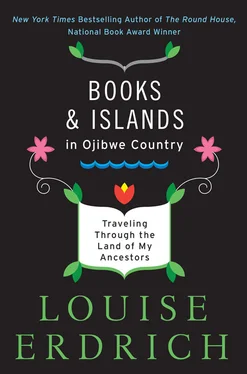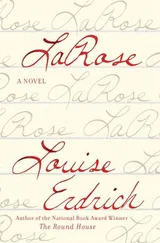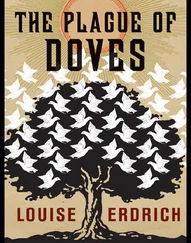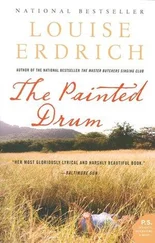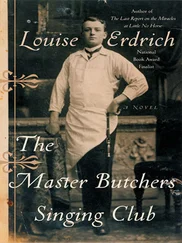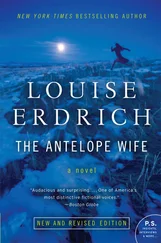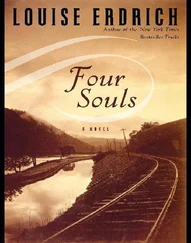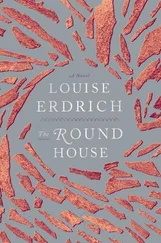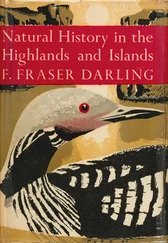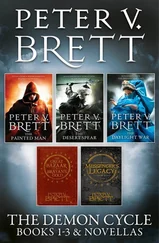One medicine I do use is a ginebig, or snake medicine. I’ve got some in a plastic baggy. Puffball powder is the spores of dried puffballs, collected from those white, round, low-growing mushrooms that grow everywhere, even on city boulevards. Put this powder on a cut or a scrape and it heals immediately. All of these medicines and countless others grow on either side of the highway in the tamarack bog, an ecosystem so vibrantly rich that traditional Ojibwe teachers and healers still go out to fast there, to show their respect for the medicines and to learn from these plants.
Red willow, stands of maple, watery alder, and birch give way at last to neat little towns and isolated farms. Up near the border, at Baudette, we buy supplies and also phone cards. The phone cards are often useless in Canada, but I buy them anyway. And then we are across the border and heading up to Morson, Ontario, through Big Grassy First Nation Reserve on a familiar little highway dotted with construction crews repairing the constant erosion and washouts. I park the blue minivan at a dock in Morson. The owner of New Moon fishing lodge, Rocky Moen, helps me unload the van and transfers the duffels, the camera equipment, the portable crib, into the lodge boat.
Rocky is a kindly and intelligent man and seems devoted to the ecology of the lake. We start talking immediately about the rock paintings as we proceed directly to the island that his family has owned since the 1950s. Rocky is intrigued with the paintings near his lodge, and he is still angry about the defacement of those paintings decades ago. “Stupid, stupid, stupid,” he says. “It bothers me a lot. I know the person who did it.” When I ask the person’s name, though, Rocky just looks pained. The trip to the island takes about forty-five minutes, and as the mainland is blazing hot this July the cool breeze is a relief. Kiizhikok stands in the whipping wind, and I hold tightly onto the handle on the back of her life jacket and grasp one leg, too, just to make sure.
Boats make me very uncomfortable. At any moment, I think we’ll ram into a rock. The boat will sink. But I’ll still be gripping the baby. I’ll tow her to shore. There are plenty of islands around here, and I never go out onto the lake without carrying in my pocket a Ziploc baggy of waterproof matches. Once I tow the baby to shore, I’ll light a fire, fan the smoke, and eventually someone will come to investigate. We will be saved. During this short ride, I become so lost in my fantasy of boat wreck that it is only with a wrench that I return to the immediate fact that we are traveling along, so far so good, and we’re not capsizing. Rocky seems completely at home on the lake. We’ll probably be safe. I don’t relax my grip on Kiizhikok, but I do force myself to abandon my fantasy and look around at the stunning beauty.
The islands jut from the lake, tall with hundred-year pines, rocky and severe. The water glitters with power and great tangles of second-growth bush ride by, cut with sloughs and passageways. High cliff faces shadowed with caves loom over us and there are dense island groupings, great lazy white rocks sprawled like animals just above the water. Clusters of birds, pelicans, appear to stand right on the water but are actually balancing on the tips of dangerous underwater reefs. Once I’m lost in the actual beauty of the lake, I relax a little and it isn’t long before we are drawing up to the lodge dock where a young Ojibwe man named Riel — for Louis Riel, the great French-Ojibwe Métis leader who came near to establishing a Métis Nation — helps us disembark.
KIIZHIKOK AND I settle ourselves into a cabin with a window that catches breezes off the lake. We’ll hear loons laughing madly all night, sometimes close and sometimes echoing from shore to shore. Outside, the great rock we’re staying on slopes dramatically into deep water. My baby actually could fall off this island. Still, living here will make it easy to set up our trips out to see the rock paintings. In the past, we’ve camped out on the islands, deciding from day to day where to pitch a tent. But I don’t want to camp with baby along. She’s quick, she’s curious, she’s smart, and she likes to put rocks in her mouth. Maybe when she’s older we can deal with open fires, slippery reefs, bugs, poison ivy, and wood ticks. Well, the wood ticks we’ll deal with anyway. Here’s one. Here’s another. They’re inevitable up here. Right now, Kiizhikok appreciates a bit of grass to run across and a predictable routine.
A period of emptiness, unusual to my life, now begins, in which I can either fret or accomplish that rare thing, the doing of nothing . Or rather, with the baby, the doing of what the baby wants. This kind of doing is very much part of the trip, and although there is a dreamy blankness to it — the hours merge and the edges of the days grow fuzzy — these times when I devote my whole self to Kiizhikok are also times of great complexity and learning.
I learn, for instance, that she can keep a little stone in her mouth for an entire day. The second morning on the island I see her bend over, pick up a little white oval stone, and touch her mouth with it. But when I pry her mouth open, I can’t find it. Perhaps I’ve just imagined that it went in. She gives me a betrayed look, clenches her jaws, and so I quit searching for the rock. We eat our breakfast and then we put on swimming suits. We sit for hours on one side of the island watching crayfish, ashaageshiinhyag , as they emerge in spidery shadows from the cracks of a half-submerged rock. They are fearless and dart for our toes, waving pincers. We remove them with sticks so we can ease off the rock and bob around in the lake together in our bright red life jackets.
We surprise an otter who has come to feast on the ashaageshiinhyag. He circles a cabin with a sinuous lope and then in confusion starts toward us. He pauses on the clipped grass of the island lawn. A huge glossy boy, his whiskers quiver comically as he takes our measure. With a fabulous flop he is down the rock, in the water, paddling off on his back. He watches us for a long time before he ducks under and is gone.
I’m very happy now. I wanted to see an otter on this trip because they are among my favorite animals and we know their feasting ground, just ten miles north. This place is in Seamo Bay. There, Kiizhikok’s grandmother and namesake, the original Nenaa’ikiizhikok, played as a child. The otter’s picnic ground is a large rock where we always find empty turtle shells. It is rather sad, but I can’t help thinking how conveniently packaged a turtle is to an otter. Like a kind of Big Mac in a crushproof box. When visiting the otters’ lunch spot, scattered with perfect empty shells, it is impossible not to imagine the otters lolling around sucking the turtles out and maybe munching a side of lichen or crayfish.
Late that night, as I am getting little Kiizhikok ready for bed, I see an unfamiliar flash of white and fish the stone from her mouth. I hold it in my hand and look at her in distress. My sister and brother-in-law are pediatricians. This stone is a classic choking hazard. Do you understand that, Kiizhikok? Choking hazard? I look into her warm round face and try to explain. She puts her hand on my arm in a motherly way and shakes her head indulgently. I recognize the look. My teenage daughters give it to me. Oh, Mom, I’m fine and you just worry too much . My head whirls. Yes, everybody else was drunk and high on crack and heroin and many other drugs you haven’t heard of don’t want to and worst of all they were keeping stones in their mouths, choking hazards, while having unprotected sex, so I sat outside the party on the porch with the fireflies and thought about how I don’t need to do these things to have a good time.
Читать дальше
